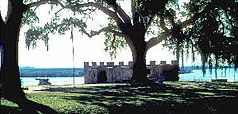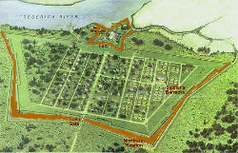Fort Frederica
| Fort Frederica National Monument | ||
|---|---|---|
| Fort Frederica today | ||
|
|
||
| Location: | Georgia , United States | |
| Specialty: | British colonial fort | |
| Next city: | Brunswick | |
| Surface: | 1 km² | |
| Founding: | May 26, 1936 | |
| Visitors: | 316,600 (2006) | |
| Plan of the settlement and Fort Frederica | ||
Fort Frederica is a British colonial fort and settlement in North America. It is located on St. Simons Island in Glynn County , Georgia . The fort was in 1736 in the marshland of the deltas of the Altamaha River on one after the settlement Frederica River built-called tributary to control vessel traffic off the coast and so the boundary between the British colonies (especially the newly founded colony of Georgia) and the Spanish Florida to protect. On May 26, 1936, President Franklin D. Roosevelt signed the fort's designation as a National Monument- Type Memorial . However, this decision was only implemented on September 10, 1945.
history
In the early 18th century, what is now Georgia as the land between the British colony of South Carolina and Spanish-ruled Florida was the constant bone of contention in a centuries-old dispute between the Spanish and the British. In 1736, General James Oglethorpe, founder of the Georgia colony on the Frederica River, with the help of English, Scottish, German and Swiss colonists, built the city and fort Frederica, in which Muskogee Indians, sometimes also referred to as Creek Indians, from the tribe of Yamacraw settled down. The settlement was named after Friedrich Ludwig von Hannover (1707-1751), as Frederick Louis , Prince of Wales . However, to avoid confusion with Fort Frederick in South Carolina, the feminine form of the name was chosen. The complex was completely surrounded by palisades, ramparts, moats and a glacis . The small, brick fort was located as a citadel within the wall and was directly on the river bank.
In 1740 Oglethorpe moved from Frederica to Florida and besieged the Spanish forts Castillo de San Marcos and Fort Matanzas, which are located near today's St. Augustine , in vain .
In 1742 Spanish troops from Florida and Cuba attacked St. Simons Island. The defensive measures initiated by Oglethorpe initially led to the Battle of Bloody Marsh , as part of the fighting also known as the War of Jenkins Ear . Here, parts of the 42nd Infantry Regiment and the Dariene Highlanders regiment under Lieutenant Patrick Sutherland attacked a Spanish reconnaissance team, with only seven dead (according to Spanish information). At first the Spaniards continued their campaign to conquer the island, but Oglethorpe repeatedly managed to outmaneuver them, so that the Spaniards finally gave up and retreated to Florida. The fact that the British had finally got the upper hand solidified their situation in this part of the country. Georgia remained under British rule.
After the Spanish danger had been averted and a peace treaty concluded between the two parties, Fort Frederica came to an end in 1748. The 42nd Regiment of Foot Infantry Regiment stationed here was disbanded, and the residents left the inhospitable place due to the constant plague of mosquitoes. Some of them returned to Europe. The fort fell into disrepair.
Todays situation
The site of Fort Frederica was declared a National Monument on May 26, 1936. In 1947, the National Park Service and the Ft. Frederica Association with archaeological excavations on the site of the former settlement. With the help of maps from the 18th century and other records from the time as a guide, the plant began to be exposed. On October 15, 1966, was included in the National Register of Historic Places ( National Register of Historic Places added). Fort Frederica is open to the public, there is a visitor center with an exhibition on colonial times and the indigenous Yamacraw Indians. Living History demonstrations in historical costumes take place several times a month . Parts of the fortifications have been reconstructed in their archaeologically determined dimensions in order to give visitors an impression of the complex.
See also
literature
- Albert C. Manucy: Fort Frederica National Monument: Historic Site Report . National Park Service, Saint Augustine, Florida 1945 (online: Historic Site Report ; PDF; 20.1 MB).
Web links
- National Park Service: Fort Frederica National Monument (official site; English)
- Archeology at Fort Frederica National Monument (PDF file; 637 kB)




